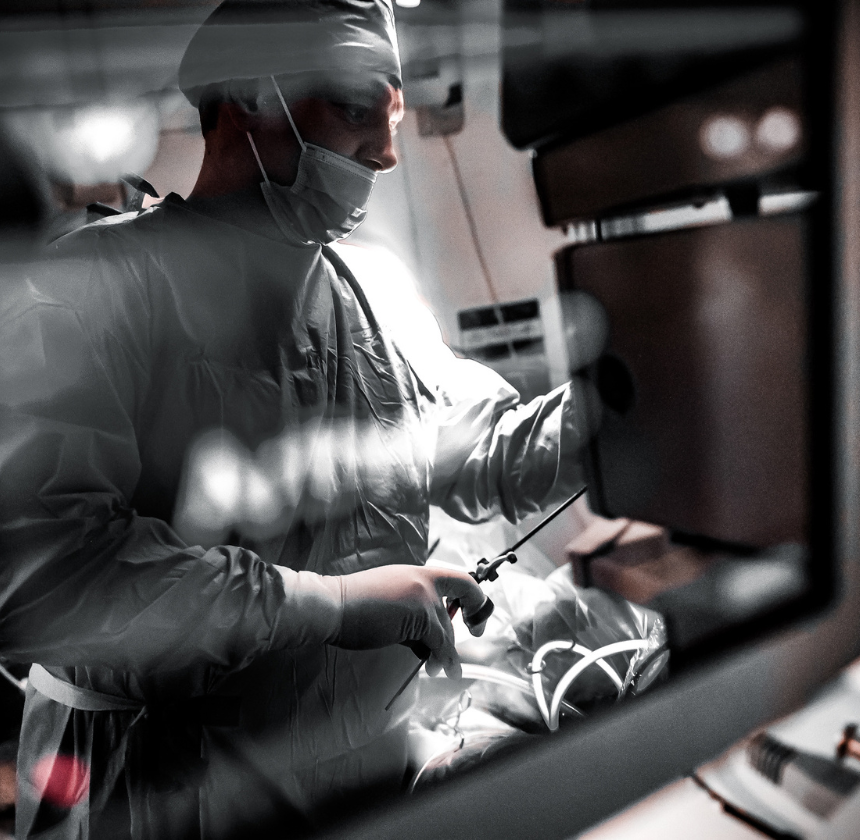Laparoscopic
Nephrectomy
Providing safer, advanced laparoscopic solutions for kidney removal in pets.
What Is Laparoscopic Nephrectomy?
Laparoscopic nephrectomy is a minimally invasive surgical procedure used to remove a kidney from a pet, often due to tumours, trauma, or severe infection. This technique uses small incisions and a laparoscope (a small camera) to allow the surgeon to perform the procedure with precision, reducing pain, promoting faster recovery, and minimising complications compared to traditional open surgery.
When is Laparoscopic Nephrectomy Recommended?
Laparoscopic nephrectomy may be recommended if your pet has symptoms that suggest an internal issue, including:
Kidney Tumours
Both benign and malignant growths that need to be removed.
Kidney Trauma
Severe injury to the kidney, especially when one kidney is damaged beyond repair.
Severe Infection or Abscesses
In cases where the infection cannot be controlled by medication and requires removal of the affected kidney.
Congenital Abnormalities
Rare cases where a malformed kidney affects health and function.
Laparoscopic Nephrectomy Procedure:
Pre-Procedure Preparation
Before the surgery, your pet will undergo a thorough evaluation, which may include blood tests, imaging (such as ultrasound or CT scans), and other diagnostics to assess kidney function and the extent of the problem. These tests help guide the surgeon in planning the best approach for the nephrectomy.
Anaesthesia and Sedation
General anesthesia is administered to ensure your pet is fully comfortable and pain-free during the procedure. This is necessary as the surgery involves working inside the abdominal cavity.
Surgical Incisions
Small incisions are made in the abdomen, through which the laparoscope and specialized instruments are inserted. These incisions are typically much smaller than those required for open surgery, allowing for a more minimally invasive approach.
Visualisation
The laparoscope provides a high-definition view of the kidney and surrounding structures, allowing the surgeon to precisely locate the affected kidney and assess the surrounding tissue. This enables a more accurate and targeted removal of the kidney.
Laparoscopic Nephrectomy
The surgeon uses laparoscopic instruments to carefully detach the kidney from surrounding tissues and blood vessels, minimising trauma. Once the kidney is fully removed, it is placed in a retrieval bag and removed through one of the incisions.
Closure & Recovery
Once the kidney is successfully removed, the incisions are closed with sutures or surgical glue. Your pet is closely monitored during recovery, typically staying in the clinic for a short time. Most pets are able to go home the same day or the following day, depending on their condition.
Laparoscopic Nephrectomy Benefits in Pets
Overall, laparoscopic nephrectomy offers numerous benefits for your furry friends, including the safe removal of a damaged or diseased kidney, reduced postoperative pain, faster recovery, and a minimally invasive approach to treating kidney-related health issues.
Minimally Invasive
Small incisions reduce tissue trauma, resulting in less pain, quicker recovery, and minimal scarring compared to traditional nephrectomy.
High Precision
The laparoscope provides clear, magnified images, allowing for highly accurate removal of the affected kidney.
Reduced Complications
Minimises risks such as infection, bleeding, and other complications associated with larger incisions or open surgery.
Faster Recovery
Pets typically experience quicker healing times and can often return to normal activities sooner.
Improved Outcomes
Effectively treats kidney diseases or masses while preserving healthy kidney tissue when possible.
Shorter Hospital Stay
Many pets can go home the same day, thanks to the minimally invasive nature of the procedure.

